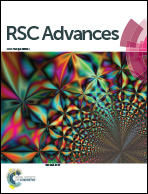Single and double chain surfactant–cobalt(iii) complexes: the impact of hydrophobicity on the interaction with calf thymus DNA, and their biological activities†
Abstract
Developing surfactant based metal complexes as metallodrugs is a promising approach for which it is important to know the effect of their hydrophobic tail part on the interaction with biomacromolecules as well as on their biological activities. In this report we describe some surfactant–cobalt(III) complexes differing in their tail part and the effect of hydrophobicity of these complexes on their interaction with calf thymus DNA and on the cytotoxic activities. The obtained results along with molecular docking calculations show that the single chain surfactant–cobalt(III) complexes interact with DNA via groove binding and double chain surfactant–cobalt(III) complexes interact with DNA through partial intercalation. In tune with this, double chain systems show more anticancer activity as their hydrophobic tail part makes them effectively penetrate into the cell. So, this kind of tuning of the hydrophobicity of metallodrugs will lead to optimisation of the DNA binding and cytotoxicity behaviour.


 Please wait while we load your content...
Please wait while we load your content...